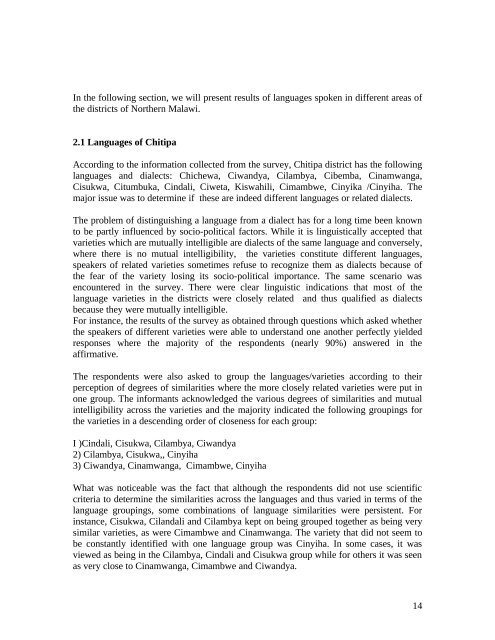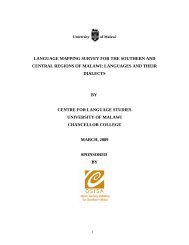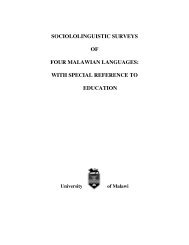languages and area spoken for chitipa - Centre for Language Studies
languages and area spoken for chitipa - Centre for Language Studies
languages and area spoken for chitipa - Centre for Language Studies
You also want an ePaper? Increase the reach of your titles
YUMPU automatically turns print PDFs into web optimized ePapers that Google loves.
In the following section, we will present results of <strong>languages</strong> <strong>spoken</strong> in different <strong>area</strong>s of<br />
the districts of Northern Malawi.<br />
2.1 <strong>Language</strong>s of Chitipa<br />
According to the in<strong>for</strong>mation collected from the survey, Chitipa district has the following<br />
<strong>languages</strong> <strong>and</strong> dialects: Chichewa, Ciw<strong>and</strong>ya, Cilambya, Cibemba, Cinamwanga,<br />
Cisukwa, Citumbuka, Cindali, Ciweta, Kiswahili, Cimambwe, Cinyika /Cinyiha. The<br />
major issue was to determine if these are indeed different <strong>languages</strong> or related dialects.<br />
The problem of distinguishing a language from a dialect has <strong>for</strong> a long time been known<br />
to be partly influenced by socio-political factors. While it is linguistically accepted that<br />
varieties which are mutually intelligible are dialects of the same language <strong>and</strong> conversely,<br />
where there is no mutual intelligibility, the varieties constitute different <strong>languages</strong>,<br />
speakers of related varieties sometimes refuse to recognize them as dialects because of<br />
the fear of the variety losing its socio-political importance. The same scenario was<br />
encountered in the survey. There were clear linguistic indications that most of the<br />
language varieties in the districts were closely related <strong>and</strong> thus qualified as dialects<br />
because they were mutually intelligible.<br />
For instance, the results of the survey as obtained through questions which asked whether<br />
the speakers of different varieties were able to underst<strong>and</strong> one another perfectly yielded<br />
responses where the majority of the respondents (nearly 90%) answered in the<br />
affirmative.<br />
The respondents were also asked to group the <strong>languages</strong>/varieties according to their<br />
perception of degrees of similarities where the more closely related varieties were put in<br />
one group. The in<strong>for</strong>mants acknowledged the various degrees of similarities <strong>and</strong> mutual<br />
intelligibility across the varieties <strong>and</strong> the majority indicated the following groupings <strong>for</strong><br />
the varieties in a descending order of closeness <strong>for</strong> each group:<br />
I )Cindali, Cisukwa, Cilambya, Ciw<strong>and</strong>ya<br />
2) Cilambya, Cisukwa,, Cinyiha<br />
3) Ciw<strong>and</strong>ya, Cinamwanga, Cimambwe, Cinyiha<br />
What was noticeable was the fact that although the respondents did not use scientific<br />
criteria to determine the similarities across the <strong>languages</strong> <strong>and</strong> thus varied in terms of the<br />
language groupings, some combinations of language similarities were persistent. For<br />
instance, Cisukwa, Cil<strong>and</strong>ali <strong>and</strong> Cilambya kept on being grouped together as being very<br />
similar varieties, as were Cimambwe <strong>and</strong> Cinamwanga. The variety that did not seem to<br />
be constantly identified with one language group was Cinyiha. In some cases, it was<br />
viewed as being in the Cilambya, Cindali <strong>and</strong> Cisukwa group while <strong>for</strong> others it was seen<br />
as very close to Cinamwanga, Cimambwe <strong>and</strong> Ciw<strong>and</strong>ya.<br />
14





